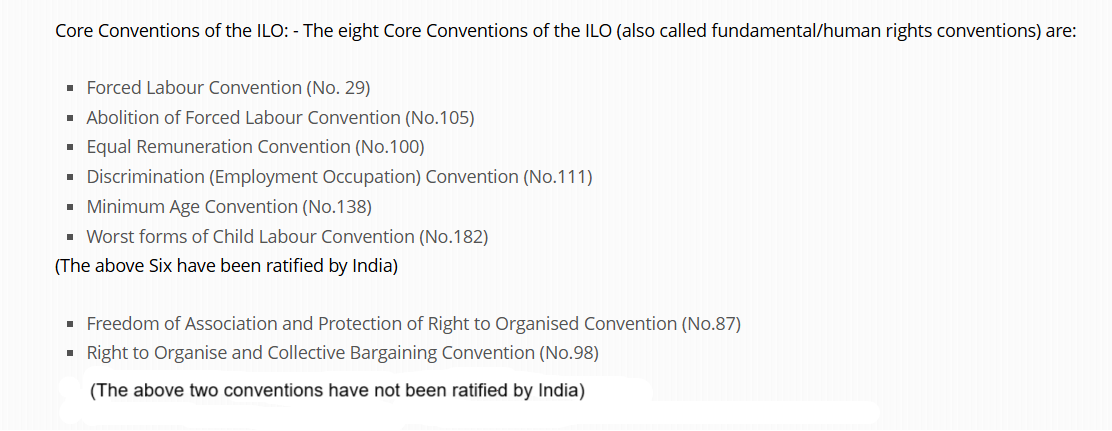Social Justice
Exploitation of Domestic Workers
- 01 Feb 2025
- 8 min read
For Prelims: Supreme Court of India, Care economy, International Labour Organization, Code on Social Security, 2020
For Mains: Domestic workers in India, Labour Laws and Reform, Welfare and Protection
Why in News?
The Supreme Court (SC) of India has raised concerns over the exploitation and abuse of domestic workers in India due to the absence of a protective legal framework.
- It has directed the Centre to form an inter-ministerial expert committee to assess the need for a protective law.
Who are Domestic Workers?
- About: According to the ILO, Domestic workers are those workers who perform work in or for a private household or households.
- They provide direct and indirect care services, and as such are key members of the care economy.
- Status of Domestic Workers in India: Women make up the majority of domestic workers in India, with 26 lakh of the 39 lakh workers being female, according to 2019 government estimates.
- 12.6 million minors are employed as domestic workers (86% are girls, and 25% are under 14 years old).
- Characteristics of Domestic Workers:
- Informal and Unregulated: Most domestic workers lack job contracts, social security, and legal protection.
- Live-in and Part-time Work: Some workers live with their employers (live-in workers), while others work in multiple households (part-time workers).
- Migration: Domestic workers often migrate from poverty-stricken states like Jharkhand, Bihar, and Odisha to cities such as Delhi, Bengaluru, and Mumbai, as well as to Arab States, due to extreme poverty and a lack of job opportunities.
- Marginalized Communities: The workforce is primarily composed of marginalized communities from Scheduled Castes (SCs), Other Backward Classes (OBCs), and Scheduled Tribes (STs).
What are the concerns of Domestic Workers India?
- Low Wages: Many earn below the minimum wage, with no formal contracts. They often work excessive hours without breaks or overtime pay.
- Abuse: Workers face physical and emotional abuse, including beatings, harsh conditions, sexual harassment, forced labour, and human trafficking, particularly minors from vulnerable communities.
- The ILO states domestic work as a "modern slavery" practice, where workers, including minors, are vulnerable to abuse, exploitation, forced labor, and trafficking.
- Sexual Harassment: Female workers are vulnerable to sexual abuse. Many cases of abuse go unreported due to fear of retaliation or the lack of legal recourse.
- Exploitation by Agencies: Placement agencies exploit domestic workers by charging high fees for employment, without guaranteeing fair wages or safe conditions.
- Workers are often not informed about the terms of their employment, including wages or job responsibilities.
- Pandemic: Covid-19 worsened conditions, a 2020 study found that 57% of domestic workers in Kochi, Delhi, and Mumbai faced discrimination, while 40% worked without safety measures.
What Laws Govern Domestic Work in India?
- No Dedicated Central Law: Domestic workers are excluded from mainstream labor laws as "workman" and "workplace" definitions do not cover household work, often seen as "unproductive" women's labor.
- Multiple attempts were made to pass a Central law to protect domestic workers, including the Domestic Workers (Conditions of Employment) Bill of 1959 and the Domestic Workers (Regulation of Work and Social Security) Bill of 2017.
- The 2019 National Domestic Worker Policy aimed to regulate agencies and ensure workers' rights, including wages, social security, and benefits. However, none of these proposed laws were enacted.
- Multiple attempts were made to pass a Central law to protect domestic workers, including the Domestic Workers (Conditions of Employment) Bill of 1959 and the Domestic Workers (Regulation of Work and Social Security) Bill of 2017.
- Weak Legal Protections:
- Unorganised Sector Social Security Act, 2008: Provided some benefits but was later replaced by the Code on Social Security, 2020, which has not been implemented.
- Minimum Wages Act, 1948: Recognizes domestic work, but only 10 states have set minimum wages for domestic workers.
- Sexual Harassment at Workplace Act, 2013: Recognizes domestic workers but lacks an enforcement mechanism.
- Child Labour (Prohibition and Regulation) Act, 1986: In 2006, India banned minors under 14 from domestic work, deeming it "hazardous child labor," but the Child Labour Act, 1986, allows children over 14 to work in homes, considering them a "safe" place.
- State Laws: Tamil Nadu, Maharashtra, and Kerala have implemented laws to protect domestic workers.
- These states have established specialized bodies to oversee social security benefits, maternity care, education assistance, medical reimbursements, and minimum wages.
- Global Protections: In 2011, India voted in favor of ILO Convention 189, which aims to improve domestic workers' conditions by recognizing domestic work as legitimate work ensuring domestic workers enjoy the same rights as others. However, India has yet to ratify the convention.
Way Forward
- Policy Changes: Implement the Draft National Domestic Worker Policy, 2019 to regulate placement agencies, ensure mandatory contracts with fair wages and benefits, and include domestic workers in social security and pension schemes.
- Ratify the ILO Convention 189, create laws to protect domestic workers' rights, recognize their work as legitimate, and ensure legal protection and policy enforcement.
- Anti-Trafficking Measures: Mandatory registration of placement agencies to ensure transparency, additionally, ensure strict enforcement of anti-trafficking laws under the Bharatiya Nyaya Sanhita, 2023 which mandates punishment up to life imprisonment for trafficking offenses, including those involving domestic workers.
- Empower Workers: Raise awareness of domestic workers' rights, provide access to legal aid and social services, and establish a statutory body to address grievances.
|
Q. Critically examine the exploitation of domestic workers in India and suggest measures to improve their working conditions and social security. |
UPSC Civil Services Examination, Previous Year Questions (PYQs)
Mains
Q. Distinguish between ‘care economy’ and ‘monetized economy’. How can the care economy be brought into a monetized economy through women empowerment? (2023)





